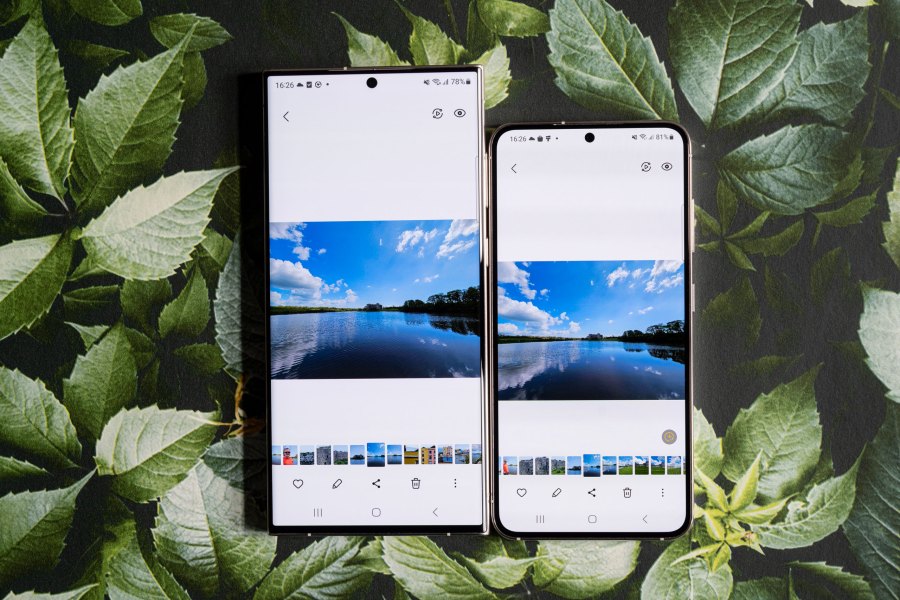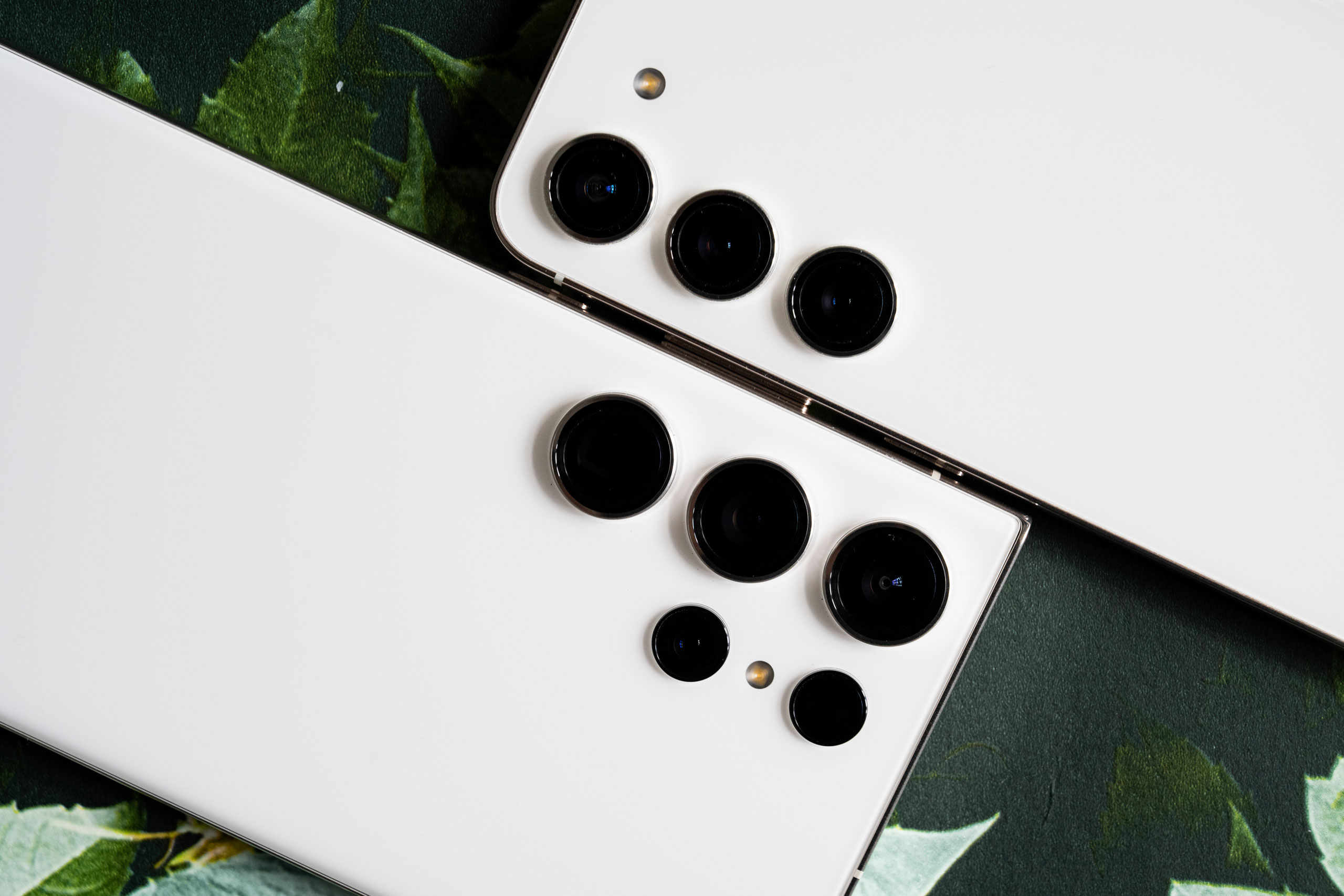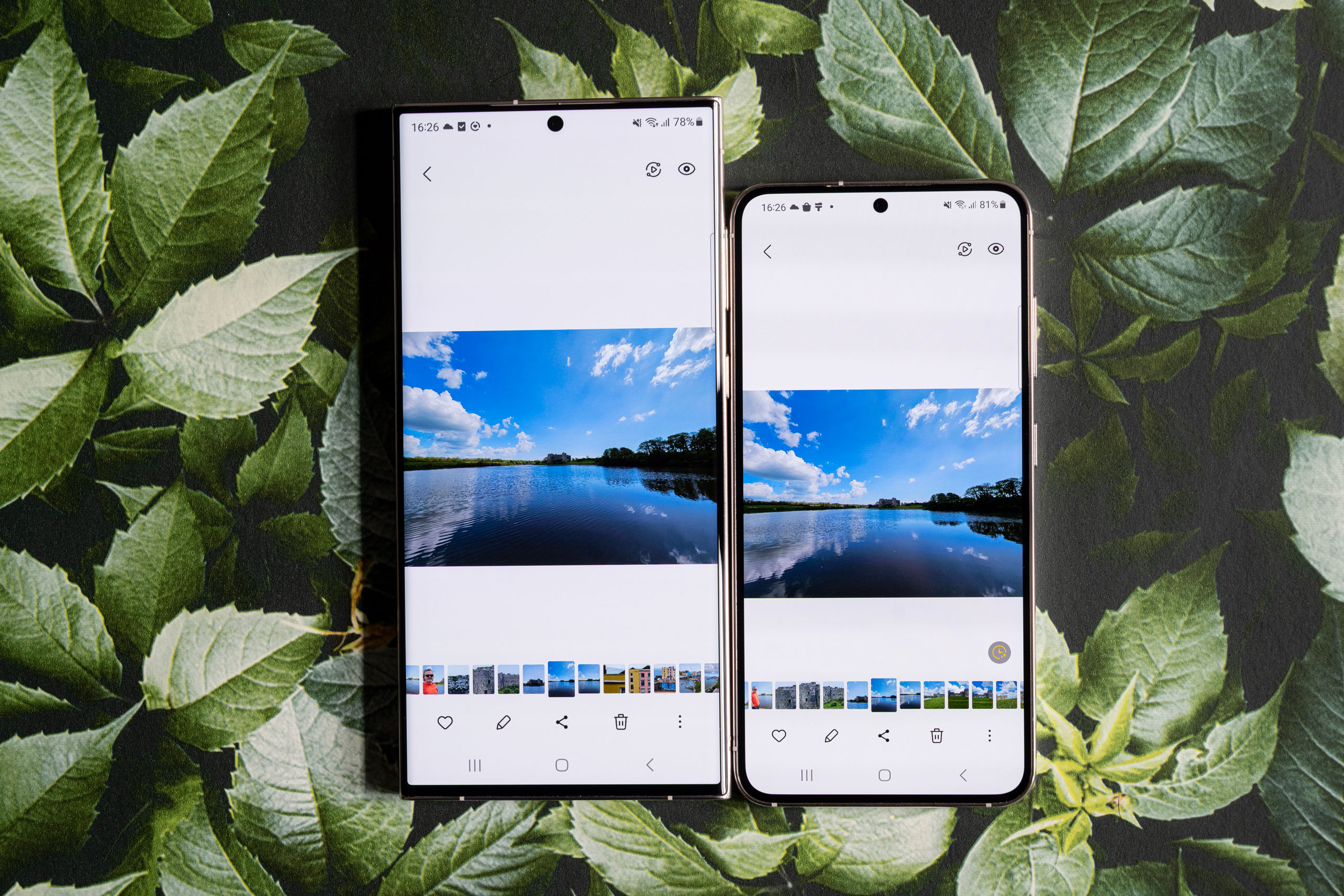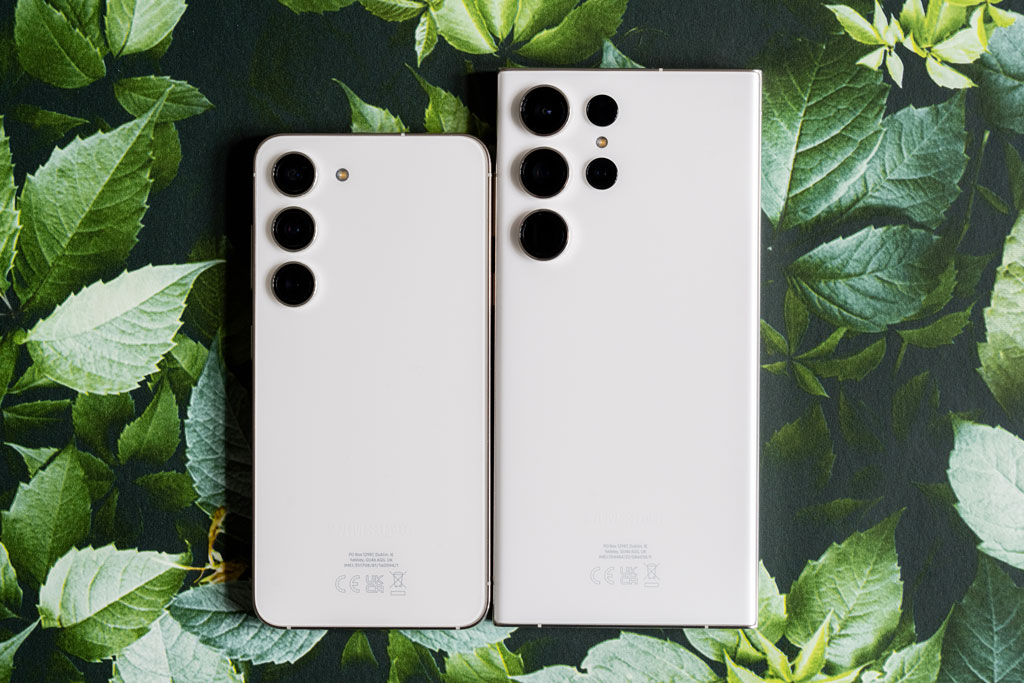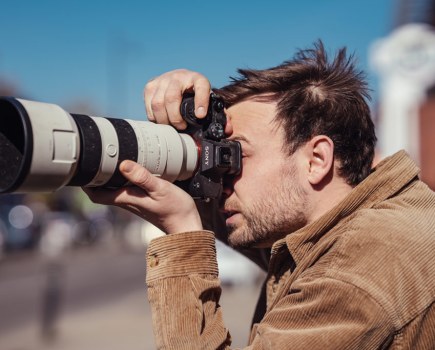If you’re looking for the best smartphone for photography, then chances are you’ll consider a Samsung. After all, we found that the Samsung Galaxy S23 Ultra was fantastic and ticked a huge number of boxes. But it’s hefty price tag is a stumbling block, and its dimensions make it tricky to handle.
In which case, could the standard Samsung Galaxy S23 be the answer? You still get an excellent smartphone, it costs a lot less, and fits in smaller pockets than the Ultra. For something that falls in the middle, there’s the S23+ which offers the same camera specifications as the S23, but has a larger screen.
To decide against the S23 Ultra is to sacrifice a few camera specs, which we’ll cover in detail shortly. Let’s see if the cost saving justifies doing so.
Samsung Galaxy S23 Ultra vs Samsung Galaxy S23: Camera specs
Both of these models boast a lot of great specifications for photographers. The S23 has a triple-lens set-up, putting it in line with most of the other flagships on the market, while the S23 Ultra goes one better with a fourth lens.
That means you get a 0.6x, 1x and 3x with the S23. The S23 Ultra has those plus a 10x lens. Both offer digital zooming, with the S23 going up to 30x, and the S23 Ultra using “space zoom” to get up to 100x.
The main (1x) lens/sensor combination appears to be one of the biggest differences between the two models. The main sensor for the S23 is a 50MP 1/1.56”sensor, whereas the S23 Ultra’s is 200MP and slightly larger at 1/1.3”. Although both have very high resolution sensors, the standard output for images is 12MP thanks to pixel binning.
While each has a 24mm focal length, the S23 Ultra’s has a slightly wider aperture of f/1.7 (compared to f/1.8 for the S23). The S23 Ultra’s main lens also has some better focusing tech, including multi-directional PDAF, laser AF. The S23 has Dual Pixel PDAF. Both the S23 Ultra and S23 have OIS in the main lens.

The ultra wide (0.6x) lenses appear to be the same in both models. They each have 12 megapixel 1/2.55” sensors, a 13mm focal length, and are f/2.2. Both the 3x lenses have a 70mm focal length, and are f/2.4. However, the cheaper S23 has a slightly smaller 1/3.94” sensor compared to the Ultra’s 1/3.52” sensor. We’ll discover whether this very slight variation makes a difference in real-world shooting.
Finally, the S23 Ultra has a 10x periscope lens. This also has a 1/3.52” sensor, with a 230mm focal length and f/4.9 aperture.
For video, both the phones offer 8K recording at 30fps, or 4K at 60/30fps, as well as a range of Full HD and HD options including slow-motion. Both offer Super Steady (though only when shooting Full HD).
A brief mention should be given here to the ’S Pen’ which you get with the S23 Ultra. This is designed primarily for taking notes on the phone, but can also be used it to trigger the shutter in the camera app. This is handy for selfies or anything taken from a distance.
On paper, it’s clear that the S23 Ultra offers more. You get a higher pixel count, an extra lens, and slightly better sensors.
Samsung Galaxy S23 Ultra vs Samsung Galaxy S23: Camera apps and modes
As you would expect, these Samsung models share the same native camera app. We’ve always been impressed by the comprehensive nature of Samsung’s native camera apps, and these are no different.
Both offer more or less the same shooting experience, including a standard Photo mode, as well as the typical smartphone modes we’re used to seeing including Portrait and Night mode. Both also have both a “Pro” mode and an even more advanced “Expert RAW” mode. If you want to shoot at higher resolution than the standard 12 megapixel output, you can select 200MP in Photo Mode for the S23 Ultra, or 50MP for the S23.
Just about the only big difference of note here is that the S23 Ultra offers an automatic macro mode which kicks in when you get close to a subject. The S23 does not do this.
Although the two phones are very similar at this point, not having macro capability is a loss for the smaller device. In order to shoot detailed close-ups you would need to invest in the more expensive option.
Samsung Galaxy S23 Ultra vs Samsung Galaxy S23: General image quality
In our individual reviews of the S23 Ultra and the S23 we found that both are capable of taking excellent images in a range of situations.
Both produce good levels of detail, and display nicely vibrant colours that aren’t too wild or over-saturated. We also found that colours are well-matched between all the lenses. There’s also very little difference between the two in terms of white balance when shooting under artificial light.
As such, the biggest difference we can see is between the two sets of lenses. Although they are broadly similar, under close examination, there’s slightly more detail in the 1x lens from the S23 Ultra. The 3x lens is also ever so slightly better in a side by side comparison. The ultra wide lenses seem to perform similarly.
As we’d expect the 10x optical lens found in the S23 Ultra does a better job than the digital version that the S23 has to rely on (though regarded in isolation, that’s pretty good). Only the S23 Ultra has the 100x “Space Zoom” option, though in fairness it’s not something we’d recommend using often; and should not be a deciding factor between the two.
It’s important to note here that the differences highlighted are minimal and only obvious if you are really looking for them. Even then you’d need to examine the images closely, having taken them in the same conditions. Otherwise, it’s hard to pick the two apart at 0.6x, 1x and 3x. It’s only if you need (or want) that 10x zoom and upwards that you should concern yourself.
Samsung Galaxy S23 Ultra vs Samsung Galaxy S23: Low light
We might expect there to be a bigger difference in low light between these two models, but in real-world shooting, it’s hard to spot much variance between them.
The 1x lens seems to show a tiny bit more detail, but again, not a deal-breaker. The ultra wide lenses seem to be more or less the same. The bigger differences come with the zoom options. Both the S23 Ultra and the S23 use a crop of the main 1x sensor when light is extremely low if you select the 3x lens. Here, the S23 Ultra is a little better, especially if you compare the two side by side.
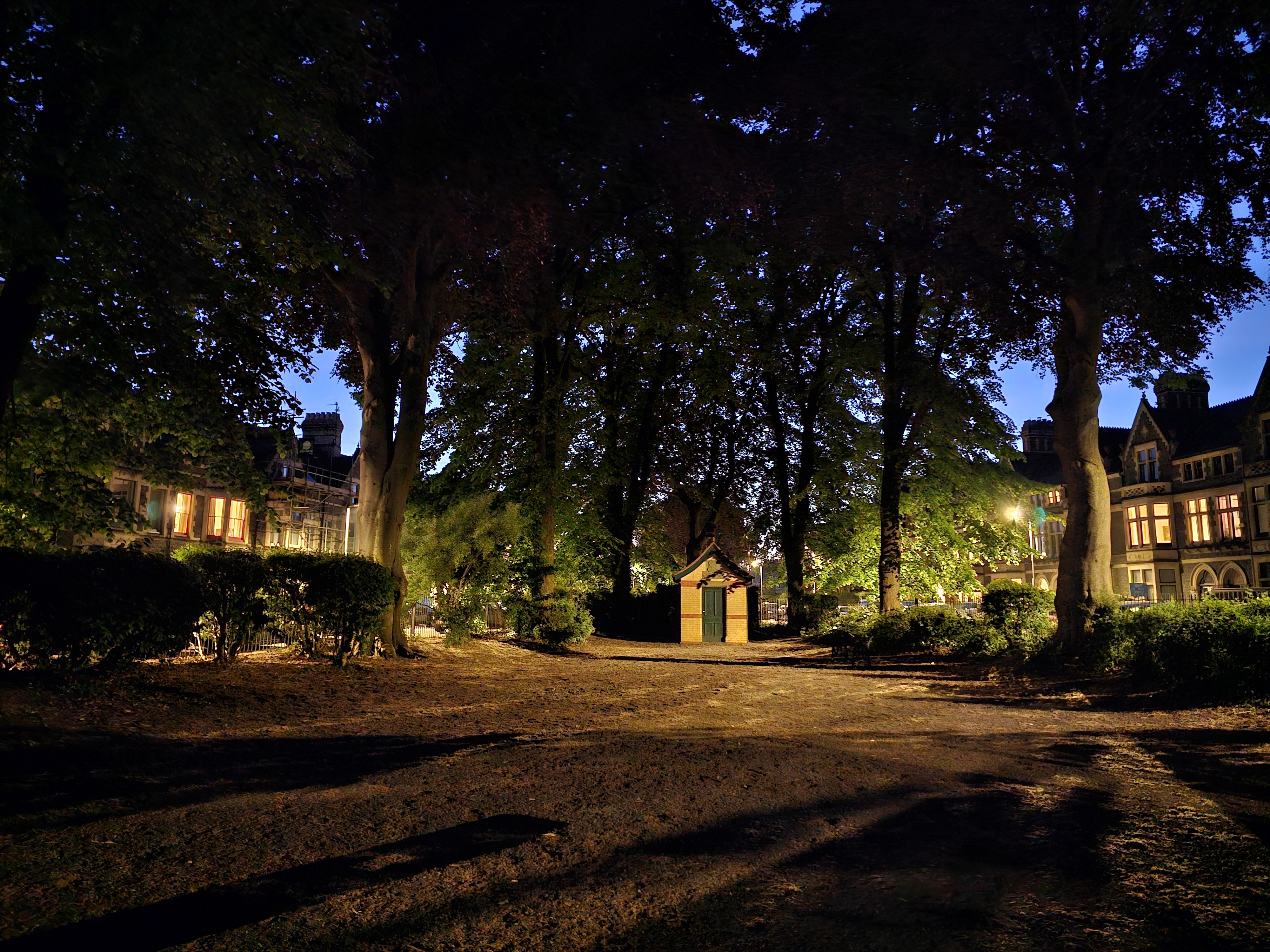
As we’d expect, the 10x option in low light is pretty poor with the S23 – this is a digital crop of the 3x lens. The S23 Ultra’s 10x option in low light is also a crop of the 3x lens, but the results produced seem to be much better.
Samsung Galaxy S23 Ultra vs Samsung Galaxy S23: Macro
This one is quite a big difference as the S23 doesn’t have a macro mode. As such, we can see that if we try to get close to the subject, it completely fails to get it in focus. Meanwhile, the S23 Ultra’s version produces lots of details.
If you shoot a lot of close-ups, or want to, then the S23 Ultra is the obvious choice here. The best workaround you can try for the S23 is to shoot at 3x from a distance.
Samsung Galaxy S23 Ultra vs Samsung Galaxy S23: Portrait

Both smartphones have the same portrait mode; offering 1x or 3x portraits, depending on how much background you want to include.
In reality, it is almost impossible to tell which was taken with which phone; they produce almost identical images. If we had to pick one, we’d say the S23 Ultra is ever so slightly better, but it’s a very close call. If you viewed each in isolation you’d be impressed with both.
Samsung Galaxy S23 Ultra vs Samsung Galaxy S23: Video
The S23 Ultra and the S23 have broadly the same video specifications, with both offering 8K and 4K video options. Obviously there are differences when it comes down to the sensor hardware used to capture video but, once again, in practice it is hard to discern any obvious differences between them here.
For those who will take a lot of videos at 10x zoom then the S23 Ultra will be the better device. For most people, there’s very little to choose between them.
Samsung Galaxy S23 Ultra vs Samsung Galaxy S23: Screen and Design
Samsung’s S23 Ultra is only available in one size – good news if you like enormous phones, as it comes in at 6.8”. It’s quite unwieldy and certainly difficult to fit in your pocket. On a more positive note, your photos and videos look excellent on its 3088 x 1440 (Edge Quad HD+) display. The physical dimensions are 163.4 x 78.1 x 8.9mm.
It’s disappointing that, unlike the iPhone 14 Pro, Samsung’s flagship model doesn’t offer a smaller version for those who prefer it. Instead, for something more pocket-friendly then you can opt for the lesser-quality S23.
The S23 has a 6.1” screen, with a 2340 x 1080 (Flat FHD+) display. Pictures still look very good, and it’s much easier to use as an actual phone. Physical dimensions are 146.3 x 70.9 x 7.6mm. It’s worth mentioning the S23+ again here, as it is 6.6” inches and shares the same specifications as the S23. It also has a 2340 x 1080 Flat FHD+ screen, while its physical dimensions are 157.8 x 76.2 x 7.6mm.
All three of the screens offer a 120Hz refresh rate, and a peak brightness of 1750 nits. All are Dynamic AMOLEDs. All three also offer IP68 waterproofing (meaning it should withstand a dunk of up to 30 minutes in 1 metre depth) and all have Armor Aluminium frames and Corning Gorilla Glass Victus 2, so all are pretty equally tough.
The S23 Ultra arguably has a sleeker design which allows for more of the physical dimensions of the phone to be used for that massive screen. The S23 and S23+ are a bit boxier, and, dare we say it, look like iPhones (or perhaps iPhones look like them – let’s not get into that here!). Which you prefer is a matter of taste and opinion.
Choosing a winner for this section is difficult as it all depends very much on what you want. For some, the massive size of the S23 Ultra is intolerable, while others love it.
Samsung Galaxy S23 Ultra vs Samsung Galaxy S23: Battery Life and Capacity
As we’d expect, the larger phone has the biggest physical battery life. The S23 Ultra has a 5000mAh battery, with a quoted life of 26 hours of video playback. The S23 has a 3900mAh battery, with a quoted battery life of 22 hours video playback.
Interestingly, the S23+ has a 4700mAh battery but a quoted battery life of slightly more than the S23 Ultra of 27 hours. Presumably, the bigger screen draws more power.
Those quoted figures relate to video playback, but this could be quite different in real-life. In general, however, we found that both the S23 Ultra and S23 lasted a full day most of the time. If you record a lot of video and take a lot of pictures (or perhaps do something else intensive like gaming) then the S23 won’t last as long. All of the phones offer wireless charging and Fast / Super Fast Charging.
In terms of capacity, the S23 Ultra is available in 256GB, 512GB and 1TB options, with relevant increases in price each time. In theory the S23 is available in 128GB, 256GB or 512GB variants, but it’s not always possible to get the 512GB version. The S23+ can be bought in 256GB or 512GB variants.
Samsung Galaxy S23 Ultra vs Samsung Galaxy S23: Price
The S23 Ultra has the kind of price tag that leaves you asking, “how much?!” But now that they don’t sell them directly, there are some decent offerings for re-conditioned models and with networks. For example, in the UK there are 512GB models up for grabs at around £540; for 1TB they go from £740. At present, they look a little more in the USA, with Amazon listing around $700 for 256GB, up to around $900 for 512GB, and $1,000 for 1TB models. Prices vary for contracts, so the overall price will be somewhat different if you opt for one of those.
If you don’t want to part with that the kind of cash for a smartphone, then the S23 is a good second choice. Here you’ll find more palatable prices. These go from about $380 / £400, with considerable variance.
Of course, cheapness doesn’t necessarily equate to good value for money. You might consider the extra you get the higher price is worth it for what you get. You might also find that opting for the higher priced version will mean you keep the phone for longer and therefore spend less overall.
Samsung Galaxy S23 Ultra vs Samsung Galaxy S23: Conclusion
On paper it seems pretty obvious that the S23 Ultra is the better option for photographers – especially those with big budgets who want the best of the best.
However, when it comes to real-world usage, it’s not as straightforward as that. Yes, the camera specs are “better” with the S23 Ultra, but ask yourself – do you really need 200MP or a 10x zoom? The answer to those is “no” and “probably not, most of the time”, in case you’re wondering.
The biggest, most obvious difference appears to be macro mode – but the extra money is quite a lot to pay for that, so ask yourself whether you need that too. The S Pen for triggering off that shutter release remotely is a neat trick – but how often are you likely to do that with your smartphone?
Then there’s size, handling, design and usability. Size is, ultimately, a subjective matter. If you do still want a bigger phone but want to save cash, the S23+ is a pretty big third option.
Conclusions must be drawn by you, sorry to say. If you need (or just want) all the bells and whistles of the S23 Ultra, then absolutely it is better. Ultimately, given the considerable price difference, users should take in their other needs from a smartphone when weighing up this choice. Those who can afford it and want one for serious photography will opt for the S23 Ultra. For the rest of us, the S23 has great cameras at its price.
Related content:
- Samsung S23 Ultra: Do you need 200 megapixels in a smartphone?
- Samsung S23 Ultra vs Samsung S22 Ultra: Do you need an upgrade to a 200MP smartphone?
- iPhone 14 Pro vs Samsung S23 Ultra: Cameras Compared
- Why do I have to buy an iPhone if I want a small flagship phone?
Follow AP on Facebook, Twitter, Instagram, YouTube and TikTok.

